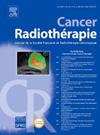可切除、淋巴结阳性、III期非小细胞肺癌患者不同淋巴结分期系统的预后意义:确定增强预后分层的最佳分类
IF 1.4
4区 医学
Q4 ONCOLOGY
引用次数: 0
摘要
传统的N分期系统不能对可切除的淋巴结阳性III期非小细胞肺癌患者,特别是术后放疗患者的预后异质性进行充分的分层。本研究的目的是确定最佳的淋巴结状态分类策略:传统的N分类,基于阳性淋巴结的分类,或基于淋巴结比例的分类。此外,我们的目的是确定使用最佳分类策略从术后放疗中获益最多的人群。方法:我们分析了5028例可切除的淋巴结阳性III期非小细胞肺癌患者的数据,这些数据来自监测、流行病学和最终结果(SEER)数据库。预后预测模型中纳入了各种淋巴结分期系统,包括传统的N分期、基于阳性淋巴结数的分类和基于淋巴结比例的分类。使用肺癌特异性生存率和Kaplan-Meier分析评估生存结果。结果淋巴结比例分类模型的预后预测性能最高,c指数、曲线下面积最高,赤池信息标准最低,阳性淋巴结分类模型次之,传统N分期模型次之。基于不同淋巴结分期系统的预后分层分析显示,淋巴结比率大于0.28且阳性淋巴结多于3个与预后高危相关。此外,术后放疗可显著提高可切除的淋巴结阳性III期非小细胞肺癌患者的肺癌特异性生存率(P <;0.05)。值得注意的是,生存曲线分析显示,在高危预后组中,术后放疗组与未放疗组的肺癌特异性生存率差异最为显著,尤其是淋巴结比大于0.28、阳性淋巴结大于3个,最后是传统的N分期模型。结论对于可切除的淋巴结阳性III期非小细胞肺癌患者,根据淋巴结比例进行分类,然后是淋巴结阳性,与传统的N分期相比,在解决预后异质性方面可能具有更好的预后预测能力。此外,确定淋巴结比例大于0.28的高危预后似乎是选择术后放疗获益候选人的最有效标准。本文章由计算机程序翻译,如有差异,请以英文原文为准。
Prognostic significance of different lymph node staging systems in patients with resectable, node-positive, stage III, non-small cell lung cancer: Identifying the optimal classification for enhanced prognostic stratification
Purpose
The traditional N staging system fails to adequately stratify the prognostic heterogeneity in patients with resectable node-positive, stage III, non-small cell lung cancer, particularly in those undergoing postoperative radiotherapy. The purpose of this study was to determine the optimal nodal status classification strategy: the traditional N classification, the positive lymph nodes-based classification, or the lymph node ratio-based classification. Furthermore, we aimed to identify the population that would benefit the most from postoperative radiotherapy using the best classification strategy.
Methods
We analysed data from 5028 patients with resectable node-positive, stage III, non-small cell lung cancer sourced from the Surveillance, Epidemiology, and End Results (SEER) database. Various lymph node staging systems, including traditional N staging, classification based on the number of positive lymph nodes, and classification based on the lymph node ratio, were incorporated into the prognostic prediction model. Survival outcomes were evaluated using lung cancer-specific survival and Kaplan-Meier analysis.
Results
The lymph node ratio classification model demonstrated the highest prognostic prediction performance, with the highest C-index, area under the curve, and the lowest Akaike information criterion, followed by the positive lymph nodes classification model and the traditional N staging model. Prognostic stratification analysis based on different lymph node staging systems indicated that a lymph node ratio greater than 0.28 and more than three positive lymph nodes were associated with a high-risk prognosis. Furthermore, postoperative radiotherapy significantly improved lung cancer-specific survival in overall resectable node-positive, stage III, non-small cell lung cancer (P < 0.05). Notably, survival curve analysis revealed the most pronounced differences in lung cancer-specific survival between the groups receiving postoperative radiotherapy or not in the high-risk prognosis group, particularly among those with a lymph node ratio greater than 0.28, and more than three positive lymph nodes, and lastly the traditional N staging model.
Conclusion
In patients with resectable node-positive, stage III, non-small cell lung cancer, classification according to the lymph node ratio, followed by the positive lymph nodes, may offer superior prognostic prediction capabilities compared to the traditional N staging in addressing prognostic heterogeneity. Additionally, identifying a high-risk prognosis with a lymph node ratio greater than 0.28 appears to be the most effective criterion for selecting candidates who would benefit from postoperative radiotherapy.
求助全文
通过发布文献求助,成功后即可免费获取论文全文。
去求助
来源期刊

Cancer Radiotherapie
医学-核医学
CiteScore
2.20
自引率
23.10%
发文量
129
审稿时长
63 days
期刊介绍:
Cancer/radiothérapie se veut d''abord et avant tout un organe francophone de publication des travaux de recherche en radiothérapie. La revue a pour objectif de diffuser les informations majeures sur les travaux de recherche en cancérologie et tout ce qui touche de près ou de loin au traitement du cancer par les radiations : technologie, radiophysique, radiobiologie et radiothérapie clinique.
 求助内容:
求助内容: 应助结果提醒方式:
应助结果提醒方式:


